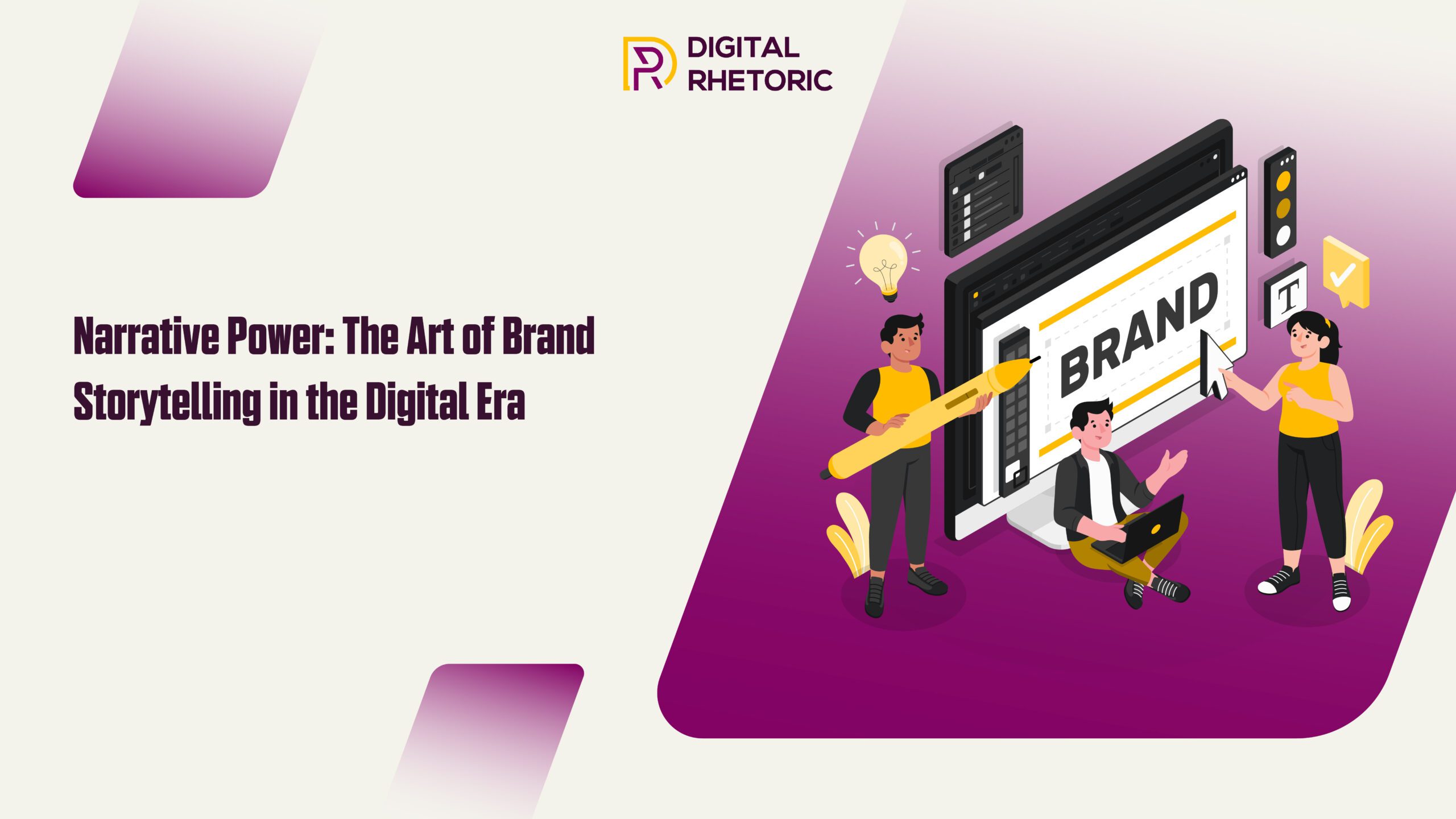Narrative Power: The Art of Brand Storytelling in the Digital Era
- Sanjay Thakore
- September 22, 2023
- Blog
- Digital Marketing Agency, Digital Marketing Company, Search Engine Optimization, Social Media Marketing, Social Media Marketing Services
- 0 Comments

In the realm of brand building, the art of storytelling has emerged as a powerful force. Crafting and sharing compelling narratives is no longer just an option; it’s a cornerstone of successful brand building strategies. In this digital age, where consumers seek connections and authenticity, understanding how to build a brand through storytelling is paramount. Join us on a journey into the world of brand storytelling, where we explore the strategies and techniques that can elevate your brand’s identity in the digital era. Visit https://digitalrhetoric.in/ to unlock the narrative power of brand building.
The Importance of Storytelling in the Digital Age
In the digital age, where information bombards us from every corner, storytelling has risen as a beacon of significance. It’s the art of weaving narratives that captivate and resonate, making brands more relatable. Effective storytelling transcends mere marketing; it forges emotional connections, fosters trust, and embeds brands in the collective consciousness. The power of storytelling isn’t confined to books or movies; it’s the driving force behind brand success in the digital era. Harnessing this power is the key to not just surviving but thriving in an age where narratives shape perceptions and define brand identities.
Crafting Your Brand’s Narrative
Crafting your brand’s narrative is akin to composing a symphony. It involves harmonizing your brand’s essence, values, and mission into a compelling storyline. A well-crafted narrative transcends the mundane and captures the hearts and minds of your audience. It should be authentic, relatable, and emotionally resonant. Whether it’s the tale of your brand’s inception, the journey of your products, or the impact on customers’ lives, every element should align with your brand’s identity. A strong narrative is your brand’s signature melody, creating a lasting impression in the digital era’s crowded and noisy marketplace.
- Character: Develop relatable characters, like your brand’s founder or loyal customers, to anchor your story.
- Plot: Create a compelling narrative arc, from the brand’s inception and challenges to its triumphs and impact.
- Conflict: Introduce obstacles or challenges your brand overcame, adding drama and relatability.
- Emotion: Evoke emotions that resonate with your audience, whether it’s joy, empathy, or inspiration.
- Visuals: Incorporate visual elements like videos, images, and infographics to enhance storytelling.
- Consistency: Ensure your brand’s story aligns with its core values, mission, and overall identity.
- Engagement: Encourage audience interaction and participation in your brand’s narrative.
- Call to Action: Conclude with a clear call to action, guiding the audience on what to do next.
Real-World Examples of Successful Brand Storytelling
- Nike: “Just Do It”: Nike’s brand narrative is synonymous with “Just Do It,” a rallying cry that inspires people to overcome obstacles and pursue their dreams. By showcasing real athletes and their stories of determination, Nike has created an emotional connection with its audience. Their ads often feature everyday people striving for greatness, alongside elite athletes like LeBron James and Serena Williams.
- Apple: The Apple Story: Apple’s brand storytelling revolves around innovation, simplicity, and challenging the status quo. From its iconic “1984” Super Bowl commercial to the “Think Different” campaign, Apple has consistently used storytelling to position itself as a pioneer in technology. The story of Steve Jobs and the company’s relentless pursuit of excellence continues to captivate audiences worldwide.
- Coca-Cola: “Share a Coke”: Coca-Cola’s “Share a Coke” campaign turned personalized branding into a global phenomenon. By replacing its logo with common names and encouraging people to share a Coke with friends and loved ones, Coca-Cola created a story of connection and togetherness. This campaign humanized the brand and fostered a sense of community among its consumers.
Storytelling Across Different Digital Platforms
- Website: Craft a compelling “About Us” page that narrates your brand’s history, values, and mission.
- Social Media: Share customer testimonials and user-generated content that highlight positive experiences.
- Blogs: Create engaging blog posts that tell stories related to your industry or the problems your products solve.
- Videos: Use video content to share behind-the-scenes glimpses, product demos, or success stories.
- Email Marketing: Incorporate storytelling into email campaigns, guiding subscribers through a narrative.
- Podcasts: Launch a podcast series that discusses industry trends, interviews experts, or shares anecdotes.
- Infographics: Design visually appealing infographics that convey data-driven stories.
- Interactive Content: Develop quizzes, polls, and interactive experiences that engage users in your narrative.
- E-books and Guides: Offer downloadable resources that provide in-depth insights or solutions to common problems.
- User Experience: Ensure your website’s design and layout contribute to a seamless and enjoyable storytelling journey.
Measuring the Impact of Your Brand’s Narrative
Measuring the impact of your brand’s narrative is crucial for evaluating the effectiveness of your storytelling efforts. Metrics like website traffic, user engagement, and conversion rates provide valuable insights into how well your narrative resonates with your audience. Social media analytics can reveal the reach and engagement levels of your storytelling posts. Customer surveys and feedback help gauge the emotional connection your narrative creates. Ultimately, tracking key performance indicators (KPIs) allows you to refine your brand’s storytelling strategy, ensuring it aligns with your goals and resonates with your target audience in the digital age.
Common Mistakes to Avoid in Brand Storytelling
- Neglecting to define a clear brand identity and narrative
- Focusing solely on self-promotion instead of providing value to the audience
- Lack of consistency in storytelling across different platforms
- Ignoring audience feedback and failing to adapt the narrative
- Overcomplicating the brand story, making it hard to understand
- Neglecting to humanize the brand and connect on a personal level
- Using excessive jargon or technical language that alienates the audience
- Neglecting the emotional component of storytelling
- Failing to differentiate the brand from competitors through storytelling
- Neglecting the visual and design aspects that enhance the narrative’s impact
The Future of Brand Storytelling in the Digital Era
In the ever-evolving landscape of digital marketing, the art of brand storytelling will continue to play a pivotal role in building and nurturing strong brand identities. As consumers increasingly seek authenticity and meaningful connections with brands, mastering the art of brand storytelling remains paramount.
In the future, successful brand building will require a deep understanding of the audience, their values, and their aspirations. Brands must adapt and craft narratives that resonate with these evolving consumer preferences. Leveraging multimedia content, such as interactive videos and immersive experiences, will be essential for brands to stand out in the digital noise.
Moreover, as technology advances, personalized storytelling experiences will become the norm. Brands will harness data-driven insights to create tailor-made narratives that engage and captivate individuals on a one-to-one level. Storytelling will transcend traditional advertising, becoming an integral part of user experiences.
Ultimately, the future of brand storytelling lies in its ability to forge genuine connections, evoke emotions, and inspire loyalty. As long as brands remain committed to mastering this art, they will continue to thrive in the digital era.
Conclusion and Key Takeaways
The art of brand storytelling in the digital era is a powerful tool for businesses looking to connect with their audiences on a deeper level. As brands navigate the ever-changing digital landscape, compelling narratives remain at the heart of successful brand building.
To harness the full potential of brand storytelling, remember these key takeaways: craft authentic and relatable stories, align your narratives with your brand’s values, engage your audience across diverse digital platforms, measure the impact of your storytelling efforts, and continuously adapt to evolving consumer preferences.
For more insights on mastering the art of brand storytelling and building a strong brand identity, visit us at DigitalRhetoric.in. Elevate your brand’s narrative and captivate your audience today.

